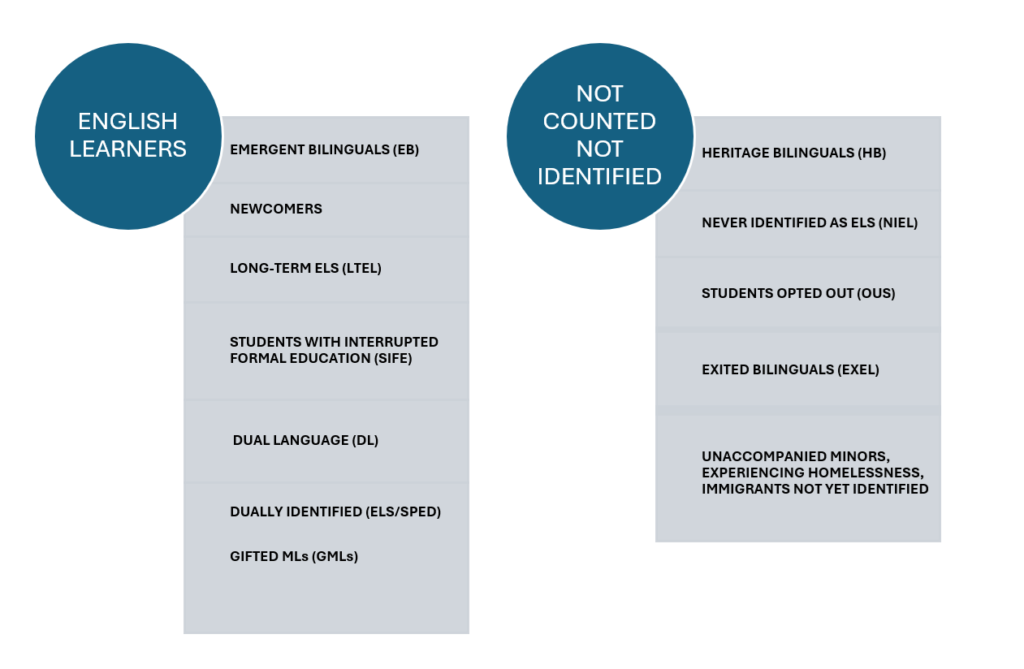by Margarita Calderón, Ph.D.
Senior Research Scientist and Professor Emerita, Johns Hopkins University
Multilingual learners have rich exciting backgrounds! Some have lived more lives than us by the time they are 11 years old. Some have learned about living through quiet introspection as they watch peers and teachers. They are in our schools to add to their wealth of experiential knowledge.
Every day, MLS do 4 times the work as other students because they have to learn or enhance:
- Language – speaking, listening, discourse, pragmatics, and the language of social-emotional competencies.
- Literacy skills – phonemic awareness, decoding, vocabulary, reading fluency, reading comprehension, spelling, syntax, writing conventions, and composition – concomitantly with the language to understand and use these skills.
- Content knowledge – they are adding knowledge and insights from math, science, social studies, language arts, music, and other special topics – concomitantly with the language and literacy skills necessary to learn across all disciplines.
- Bicultural – able to function in the home and school cultures, being proud of both cultures and the benefits of excelling in each.
Cada niño es un mundo. Yet, we label them for the benefit of educational institutions. These are some of the current labels.
The term ‘multilingual’ seems to be the umbrella for all the subcategories. Under that umbrella, there is variation in English proficiency, years of education or no education, knowledge of one or more languages, socioeconomic status, homelessness, refugee status, undocumented status, religion, and extraordinary survival strengths and worldly smarts.
The variety of terms includes: English learners (ELs) which is the official term that USDOJ and USDOE still use in their documents. Multilingual learners (MLs) is the term most educators currently prefer. Yet, it also creates confusion. Multilingual means someone who speaks several languages. But, it is more commonly used to indicate a room full of MLs, students who speak different languages and have different ethnicities, and/or a handful of officially identified as ELs. ELs are sometimes called English language learners (ELLs). Some states like Texas prefer emergent bilinguals (EBs) to encompass all categories. A teacher might have two newcomers and will call them MLs or EBs. In some cases, the term newcomers will be used due to the specific needs of newcomers, which are very different from those of Long-Term ELs (LTELs) or never-identified ELs (NIELs). Dually identified are students who need special education and ESL support, sometimes known as SPED-ESL. Some ELs/MLs have also been dually identified as gifted GMLs. Students who are in bilingual or dual language immersion programs are known as DL students. Students who have met assessment criteria and are no longer ELs are called Exited Bilinguals/MLs. Then, some students have never been identified or labeled as ELs/MLs.
The Diversity of Multilingual Learners

©Gottlieb & Calderón (in press). Together We Can! ¡Juntos Podemos! (Velazquez Press).
Some MLS (sometimes spelled MLs) are labeled by their scores on assessments. Those also vary as we can see here.
| ASSESSMET | LEVEL 1 | LEVEL 2 | LEVEL 3 | LEVEL 4 | LEVEL 5 | LEVEL6 |
| WIDA Consortium – ACCESS | Beginning | Emerging | Developing | Expanding | Bridging | Reaching |
| ELPAC California | Emerging | Expanding | bridging | |||
| TELPAS Texas | Beginning | Intermediate | Advanced | High advanced | ||
| NYSESLAT New York | Entering | Emerging | Transitioning | Expanding | Commanding |
©Calderón (in press). Coaching For Multilingual Excellence: Strategies For Vocabulary, Reading, And Writing Across Disciplines (Corwin Press).
The Offices of Civil Rights from the U.S. Departments of Education and Justice offered these guidelines for language services according to English proficiency levels (Dear Colleague Letter, January 2015) which are still pretty much in effect. Their recommendations include having highly qualified teachers for MLs and teacher support systems that include a comprehensive professional development program with coaching.

©Calderón (in press). Coaching For Multilingual Excellence: Strategies For Vocabulary, Reading, And Writing Across Disciplines (Corwin Press).
Going Beyond Federal Guidelines and Labels
Take a look at graphic #1 and add the number of students you or preferably your school has in each category ( see the top row) that need each type of service (see the right column).
Use this chart to ascertain the type of services your students need.
| Newcomers | Levels 3 – 4 | Long-Term ELs | Exited MLs or not identified | TYPE OF INSTRUCTION |
| Phonemic awareness (sounds of letters) | ||||
| Phonics (decoding) | ||||
| Vocabulary (explicit and integrated into phonics, reading, all subjects)Tier 1, 2, 3 words | ||||
| Fluency (accuracy, word recognition, prosody, speed) | ||||
| Comprehension (making meaning, critical thinking) | ||||
| Syntax (morphology, sentence structure, writing) | ||||
| Background building (for each subject area) | ||||
| Discourse protocols (sentence frames, tools, all-day practice accountability) | ||||
| Close reading strategies (Partner reading for fluency & verbal summaries) | ||||
| Cross-linguistic awareness (use of first language strategically, on-going pride in first language) | ||||
| Strategies for anchoring language, literacy and content | ||||
| Social-emotional learning (self-management, self-awareness, social awareness, relationship skills, responsible decision-making) |
©Calderón, M.E. (in press). Multilingual Learners in Grades 4th – 12th (Solution Tree).
Addressing the diversity of MLs means being mindful of individual needs. One ESL pull-out program for all levels of MLs will not help. ESL/ELD classes need to intensely address language and literacy needs by the numbers in the graphic organizer only for those students who need that category of instruction. This graphic organizer will also help co-teaching situations where both general education and ESL/ELD teachers can plan and schedule a systematic targeted approach.
GOOD LUCK EVERYONE! THANK YOU FOR ALL YOU DO FOR OUR ELS/MLS/EBS!!